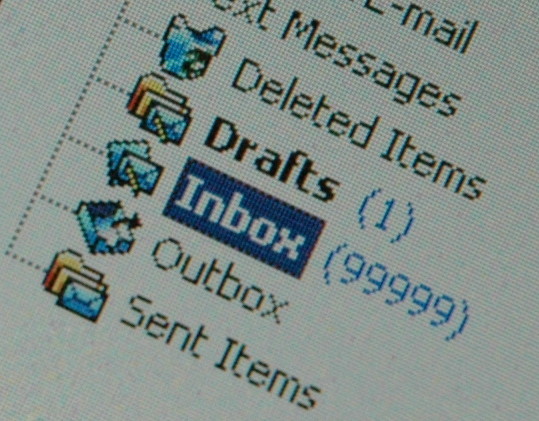Thanks to my friend Allan Schoenberg, I ran across this Muse post the other day.
While I applaud the concepts and ideas in this post (don’t we all?) the harsh and unfortunate reality is that email still rules all as a business communications tool. And it’s going to be next-to-impossible (fight the good fight!) to get colleagues and clients to adhere to these rules (not to mention the fact that I can’t IM or text most clients).

And since email is still the gold standard of business communications (whether we like it or not), we’re still chained to it. Almost literally in some cases.
But, that doesn’t mean there shouldn’t be rules around HOW to better use email. Especially when it comes to communicating with our most important audience–our clients (also applies for corporate folks–you still have “clients” even if you’re internal!).
So, what are these golden rules for using email with clients? I came up with five, in no particular order:
#1 — Use the “reply all” with EXTREME DILIGENCE.
I can’t emphasize this one enough. In fact, no amount of emphasis would be enough based on how I’ve seen full-grown adults using the “reply all” function lately. In a business setting, you should be very careful about using that “reply all.” In fact, I would almost argue you should very rarely use it. The classic instance is when you’re copied on a “reply all” with a series of to-dos and bullets within it. Resist the urge to reply all. Instead, only send to those who actually have to know what it is you’re responding to/with.
#2 — Resist sending the “Thanks” email.
I know, as communicators, we want to over-communicate. We want to dot every “I” and cross every “T”. But, by sending all those “Thanks!” emails, you’re just cluttering up your colleagues and clients inboxes. And, in effect, you’re accomplishing nothing. They sent you the note. They assume you read it. Leave it at that, if you have nothing substantive to add.
#3 — Never respond after hours–unless it’s, you know, an actual emergency.
You want balance? Here’s your chance–but you have to set the ground rules early. Resist the urge to respond to emails after hours and on the weekends. Most of it can wait until tomorrow/Monday anyway. Now, in crisis or emergency-type situations, yes, by all means, respond. But I would argue those are pretty few-and-far-between. Once you start responding to emails after the bewitching hour, that colleague or client will expect you to ALWAYS respond to emails after hours. Don’t do it. If you can help it.
#4 — If you’ve traded more than 3 emails, give her a call.
Classic case: You email your colleague about a project and a to-do he’s responsible for. He responds clarifying your question. You respond with more information. He responds that he still has a few questions before he can execute. That’s when you pick up that thing we call a telephone and call your colleague to hash it out. You see, some things are just meant to be managed voice-to-voice. Not everything can or should be done electronically, believe it or not.
#5 — Use your subject lines wisely.
Picked up a good tip early in my career that has served me well over the years: use those subject lines shrewdly. For example, if you have an urgent need and you need to communicate it via email (vs. the phone), use “URGENT–IMMEDIATE ACTION NEEDED” in the headline. I know this probably seems offensive to some (and for others, it’s a style thing), but I’ve found this to be very useful in spots. Another case: You know your client is mobile, but she’s checking her phone. Why not try to use the subject line as your chance to get her attention and immediate action? Instead of listing out an email full of details which she’ll never have time to read, why not use “Got 5 minutes for quick call to discuss an urgent item?” She’ll see this in scanning her phone (because it’s the subject line) and if she has the time, I’d be willing to bet she’ll respond. Use that subject line wisely.
#6 — For God’s sake, keep it short!
A while back, I had a boss whom I remember sent very short emails to clients. I mean, ridiculously short. And I remember thinking (initially), “that’s odd, why would she send such a short message to a client.” Years later, I know the answer: They have limited time. Most “clients” are stuck in meetings most of the day–or they’re, you know, doing work and stuff. Much like us, they don’t have time for 150 emails over the course of a day. So, the shorter and more succinct you can keep your message, the better. Bonus points for using bullets and one-line sentences when possible.
OK, those are my quick tips. What about you? What’s worked well over the years when it comes to responding to client emails?
photo credit: xJason.Rogersx via photopin cc

0 Comments